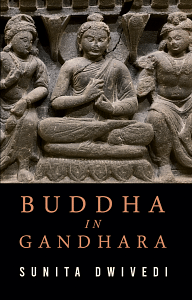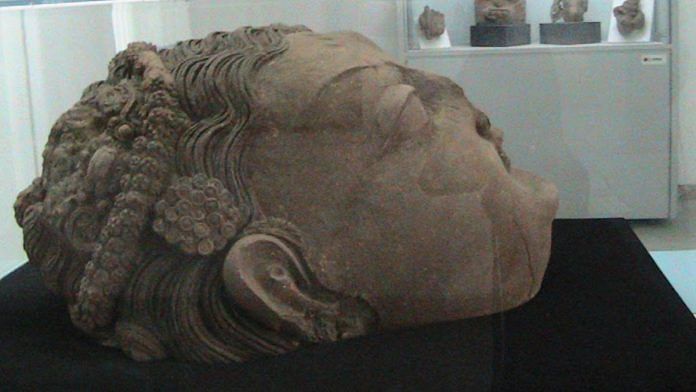The presence of Hindu gods in Central Asia is the evidence of cross-fertilization of local and Indian cultures during the pre-Islamic period. It also points to the migration of Indians to Central Asian cities, not only the Zerafshan Valley at Penjikent but also the valley of the Syr Darya (then known as Jaxartes) at Ferghana and the Amu Darya (then known as Oxus) valley at Arytam.
Any visitor to the Rudaki Museum at Penjikent in Tajikistan and the National Museum at Dushanbe can immediately identify the Hindu gods and goddesses on display. There are images of a goddess riding a lion at the Museum of Antiquities, Dushanbe, as well as others such as Siva and Parvati—Siva with a third eye and Siva with three heads, amongst others. At the Rudaki Museum, Siva is seen sitting in a vast arena that resembles wilderness with his trisul or trident next to him.
Among the images of local divinities found in Temple II, one was identified as that of Uma Maheshwar (Siva and Parvati) sitting on the Nandi bull. Incidentally, the Pharro-Ardoxsa image at Ayrtam in the Oxus valley is also believed to be closer to the portrayal of Siva and Parvati.
Renowned Indian scholar and archaeologist S.P. Gupta has noted the presence of Hindu deities, such as Brahma, Indra, Siva, Narayana and Vaisravana in Central Asia, who had their own local counterparts.
It is important to note that nearly 25 marble sculptures and other artefacts of Hindu art dated between the fifth and eighth century ad have been discovered in Afghanistan.
Also read: India was a land of dharma but Europeans reduced it to Hinduism, Islam. And we accepted it
Monastery Of Tepe Sardar At Ghazni
When the Islamic armies attacked Afghanistan in seventh century ad, Buddhism was flourishing in the province of Ghazni. One of the monastic centres located on a hill at Tepe Sardar had richly decorated stupas, chapels and monk cells which were excavated by modern archaeologists in the early twentieth century.
The Tepe Sardar Buddhist sanctuary occupying a hill of the Dasht-i-Manara plain was excavated by the Italian Archaeological Mission led by Giovanni Verardi between 1960 and 2003. An inscribed votive pot found at the site attested to the name of the sanctuary as the Kanika Maharaja Vihara, meaning the Temple of the Great King Kanishka. It also said that it was built during the Kusana period in the second century ad. Following the attack by the Islamic armies, it was abandoned in the late eighth–ninth century ad.
The 22-metre square towering central stupa was the focus of the complex and could be the largest yet found in Afghanistan. The chapels surrounding the stupa contain evidence of the colossal statuary art in the form of murals and painted clay images of the Buddha and bodhisattvas. Their fragments have been recovered during excavations. Massive gilded images of the Buddha have also been found at the entrance of the sanctuary. A gigantic Reclining Buddha measuring over 15 metres was found in Chapel 63 of the Tepe Sardar monastic complex. Unfortunately, as per the notice put up by the National Museum, it has been completely destroyed in recent times.
Yet another notice by the National Museum of Afghanistan at Kabul states that although Buddhism had spread in the Ghazni area since the time of Asoka in the third century bc, this particular complex whose main stupa was the largest in Afghanistan was built in third century ad during the Kusana period, and thrived for nearly six centuries until the arrival of the Arabs.
A large head of the Buddha dated fifth–seventh century ad from Tepe Sardar is an example of the beautiful statuary art from Ghazni, which can be seen at the museum in Kabul. The Buddha head must have adorned a life-size image of the Buddha in dhyan mudra. Made of clay, the Buddha’s eyes are closed in meditation. The thin, long, curved brows and a high nose appear to be finely chiselled. Small volutes adorn the head and the hairline is sharply drawn.
Another image of grey-blue schist dated from the fifth–seventh century ad is headless, and the throne or the pedestal depicts monks and disciples holding out a large tray of lotus flowers at the Buddha’s feet.
![A painting from Dilberjin tepe dated 1st-3rd century CE, Afghanistan shows figures with beautiful faces resembling Hindu god and goddess,. [courtesy National Museum of Afghanistan, Kabul]](https://static.theprint.in/wp-content/uploads/2021/01/dilberjin-tepe.jpg)
Also read: ‘We the people of Pakistan, irrespective of religion, are the true Indians’
Goddess Durga at Ghazni
Interestingly, the complex also hosted a Hindu Shaivite shrine where an image of Durga Mahisasur Mardini was found during excavations. The size of the original image can be guessed from the colossal head of the goddess preserved in a glass case at the national museum. The image is evidence that female divinities were worshipped in Afghanistan.
In Chapel 23 at Tepe Sardar, excavators also found the decapitated body of Mahisasur, the ‘Buffalo Demon’, with his severed head lying beside it. This was once part of a composite sculpture depicting the victory of the many-armed Durga over Mahisasur, the demon and enemy of the gods. According to explorer-historian Nancy H. Dupree, Durga defeating Mahisasur was a popular cult theme under the Hindu Shahis—the Hindu dynasty ruling over Kabul Valley and Gandhara after having taken over from the Turki Shahis.
It is possible that the Hindu Shahis installed Durga’s image in the Buddhist monastery. It is a good example of the absorption of Hindu deities in the Buddhist pantheon, and also points to the fact that Buddhist shrines were converted into Hindu shrines. This has been discussed by Indologist and art historian P. Banerjee in New Light on Central Asian Art and Iconography. In his interesting study, Banerjee explains that though subordinate in position, these Hindu deities made their original importance felt now and then even in the Buddhist framework.
Banerjee presents several examples of the popularity of Shaivism in Central Asia and about Buddhist scholars such as Asanga and Aryadeva who tried to assimilate Hinduism and Buddhism. It is generally believed that Asanga, the well-known Buddhist philosopher from c.ad 400, created an amalgam of Shaivism and Buddhism, as Aryadeva did in bringing Vaishnavism and Buddhism together. Banerjee, says that Asanga tried to reconcile ‘two opposing myths by placing a number of Saiva gods, both male and female in the inferior heavens of the prevalent Buddhism as worshippers and supporters of Buddha and Avalokitesvara’.
According to Banerjee, Asanga by reconciling Shaivism and Buddhism made it possible for:
[T]he half-converted and rude tribes to remain Buddhists while they brought offerings to their more congenial shrines and while their practical religion had no relation at all to the truth of the noble Eightfold path.’
Bannerjee also suggests that the popularity of Shaivism continued in Afghanistan and other parts of Central Asia during the late Gupta and early medieval periods. In Afghanistan, a collection of Shaiva antiquities, attributable to the seventh–eighth century ad, has come to light from the regions of Togao and Gardez. These include a head of Shiva from Gardez and a smaller head of Durga overcoming Mahisasur. This is an evidence of the spread of Hindu worship during the seventh and eighth centuries when large parts of Afghanistan were under the rule of the Hindu Shahi kings. This list includes the ‘inscribed Mahavinayaka’ or Ganesa with ‘Urdhvamedhra’ or erect phallus, clad in a tiger skin from Kotal-i-Khair Khaneh, about 17 km from Kabul and dated to the seventh century ad. Banerjee mentions the inscribed Uma-Mahesvara image, also dated to the seventh century from Tapa Skandar.
 Excerpted with the permission of Rupa Publications from Buddha in Gandhara by Sunita Dwivedi. Hardback; 336pp with colour inserts; Rs 795
Excerpted with the permission of Rupa Publications from Buddha in Gandhara by Sunita Dwivedi. Hardback; 336pp with colour inserts; Rs 795





Entire afghanistan needs to do ghar wapsi to hinduism ASAP
Entire afghanistan needs to do ghar wapsi to hinduism ASAP
This proves cult disapproving idol-worship is obsessed in breaking them while Orginal spiritual Thought shall be the last ONE standing.
“Courage” is in withstanding, NOT destroying those you cannot WIN straight.
I am very sad after seeing this. We and our great peaceful religion is just shrinking day by day. Well Hinduism itself says that nothing is shashwat aka constant. So I accept the reality but wish that the present government must bring the artefacts to India.
These are not just artefacts but the silent soul which remind the world about the glory of Hindu-Buddhist Civilization in Afghanistan.
Not sure how it is shrinking day by day.
Is shrinkage by population or area? Afghanistan is a totally different country now. It was not even created because of partition. A religions greatness is not by the area it occupied but by the length of time it has survived.